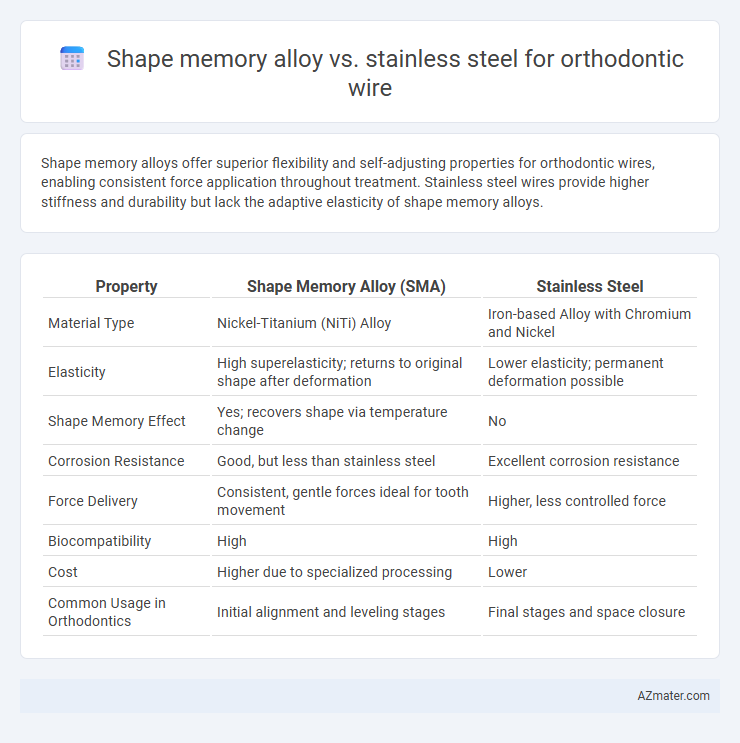Shape memory alloys offer superior flexibility and self-adjusting properties for orthodontic wires, enabling consistent force application throughout treatment. Stainless steel wires provide higher stiffness and durability but lack the adaptive elasticity of shape memory alloys.
Table of Comparison
| Property | Shape Memory Alloy (SMA) | Stainless Steel |
|---|---|---|
| Material Type | Nickel-Titanium (NiTi) Alloy | Iron-based Alloy with Chromium and Nickel |
| Elasticity | High superelasticity; returns to original shape after deformation | Lower elasticity; permanent deformation possible |
| Shape Memory Effect | Yes; recovers shape via temperature change | No |
| Corrosion Resistance | Good, but less than stainless steel | Excellent corrosion resistance |
| Force Delivery | Consistent, gentle forces ideal for tooth movement | Higher, less controlled force |
| Biocompatibility | High | High |
| Cost | Higher due to specialized processing | Lower |
| Common Usage in Orthodontics | Initial alignment and leveling stages | Final stages and space closure |
Introduction to Orthodontic Wires
Orthodontic wires play a crucial role in aligning teeth by applying controlled forces in braces treatment. Shape memory alloys, such as nickel-titanium (NiTi), offer superior flexibility and the ability to return to their original shape after deformation, providing consistent archwire activation over time. Stainless steel wires, known for their high strength and corrosion resistance, deliver greater stiffness and precise tooth movement but lack the superelastic properties of shape memory alloys.
Overview of Shape Memory Alloy
Shape memory alloys (SMAs), primarily composed of nickel-titanium (NiTi), exhibit unique properties such as superelasticity and shape memory effect, making them ideal for orthodontic wires. These alloys deliver consistent, gentle forces over time, promoting efficient tooth movement while minimizing patient discomfort compared to traditional stainless steel wires. Their biocompatibility and corrosion resistance further enhance their performance in the oral environment.
Properties of Stainless Steel Wire
Stainless steel orthodontic wires exhibit high tensile strength, excellent corrosion resistance, and superior stiffness compared to shape memory alloys, making them ideal for precise tooth movement and long-term durability. Their biocompatibility and ease of manipulation allow for reliable arch form retention and consistent force application. These properties contribute to stainless steel wires being a preferred choice in various orthodontic treatments requiring robust and stable performance.
Mechanical Strength Comparison
Shape memory alloys (SMAs), such as nickel-titanium, exhibit superior mechanical strength and flexibility compared to stainless steel, allowing for consistent, gentle force application in orthodontic treatment. Stainless steel wires provide higher stiffness and greater tensile strength, which offers better control for complex tooth movements but may cause increased patient discomfort. The balance between the elastic modulus and yield strength in SMAs promotes shape recovery after deformation, whereas stainless steel maintains rigidity without shape memory properties.
Flexibility and Elasticity Differences
Shape memory alloys, primarily nickel-titanium (NiTi), exhibit superior flexibility and elasticity compared to stainless steel orthodontic wires due to their unique ability to undergo significant deformation and return to their original shape through phase transformation. Stainless steel wires provide higher stiffness and strength but lack the extensive superelastic properties found in NiTi, resulting in less consistent force delivery and diminished flexibility. The enhanced elasticity of shape memory alloys allows for continuous, gentle forces that improve patient comfort and treatment efficiency in orthodontic applications.
Biocompatibility and Safety
Shape memory alloys (SMAs), such as nickel-titanium (NiTi), exhibit superior biocompatibility due to their corrosion resistance and lower ion release compared to stainless steel, reducing allergic reactions and tissue irritation in orthodontic applications. Stainless steel wires, while mechanically strong and cost-effective, have higher nickel content that may trigger hypersensitivity in some patients, posing safety concerns over prolonged oral exposure. The unique superelasticity of SMAs also allows for lighter, more consistent forces on teeth, enhancing treatment safety by minimizing root resorption and discomfort.
Clinical Performance and Efficiency
Shape memory alloy wires exhibit superior clinical performance in orthodontics due to their ability to deliver consistent, low-force levels that enhance tooth movement efficiency and patient comfort. Stainless steel wires provide excellent strength and control but lack the elasticity and shape recovery properties, making them less efficient in continuous force application. The combination of nickel-titanium shape memory alloys with stainless steel wires optimizes overall treatment outcomes by balancing flexibility and rigidity.
Cost-Effectiveness Analysis
Shape memory alloy (SMA) orthodontic wires offer superior flexibility and continuous force application, resulting in shorter treatment durations compared to stainless steel wires. Although SMA wires are generally more expensive upfront, their efficiency in reducing the number of adjustments and overall treatment time makes them cost-effective in long-term clinical use. Stainless steel wires, while cheaper initially, often require more frequent replacements and adjustments, increasing cumulative costs over the course of orthodontic treatment.
Patient Comfort and Experience
Shape memory alloys, such as nickel-titanium (NiTi), provide superior patient comfort in orthodontic wires due to their consistent, gentle force delivery and ability to return to their original shape after deformation, reducing the need for frequent adjustments. Stainless steel wires, while strong and durable, exert higher and less consistent forces that can lead to increased discomfort and irritation during treatment. Patients typically experience less pain and smoother tooth movement with shape memory alloy wires, enhancing overall treatment satisfaction.
Conclusion: Choosing the Optimal Orthodontic Wire
Shape memory alloy orthodontic wires offer superior flexibility and consistent force application, enhancing patient comfort and treatment efficiency compared to stainless steel. Stainless steel wires provide excellent rigidity and durability, making them ideal for final alignment and stabilization phases in orthodontics. Selecting the optimal wire depends on treatment goals, with shape memory alloys preferred for initial levelling and alignment, while stainless steel is favored for strength and control during later stages.

Infographic: Shape memory alloy vs Stainless steel for Orthodontic wire
 azmater.com
azmater.com